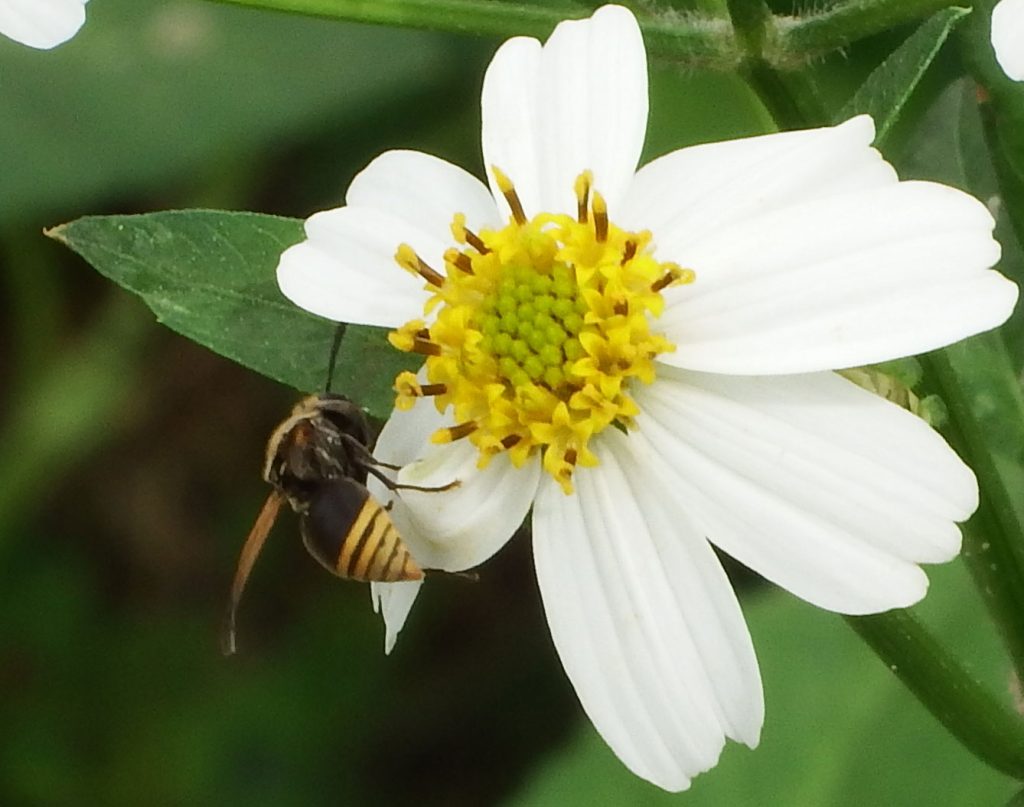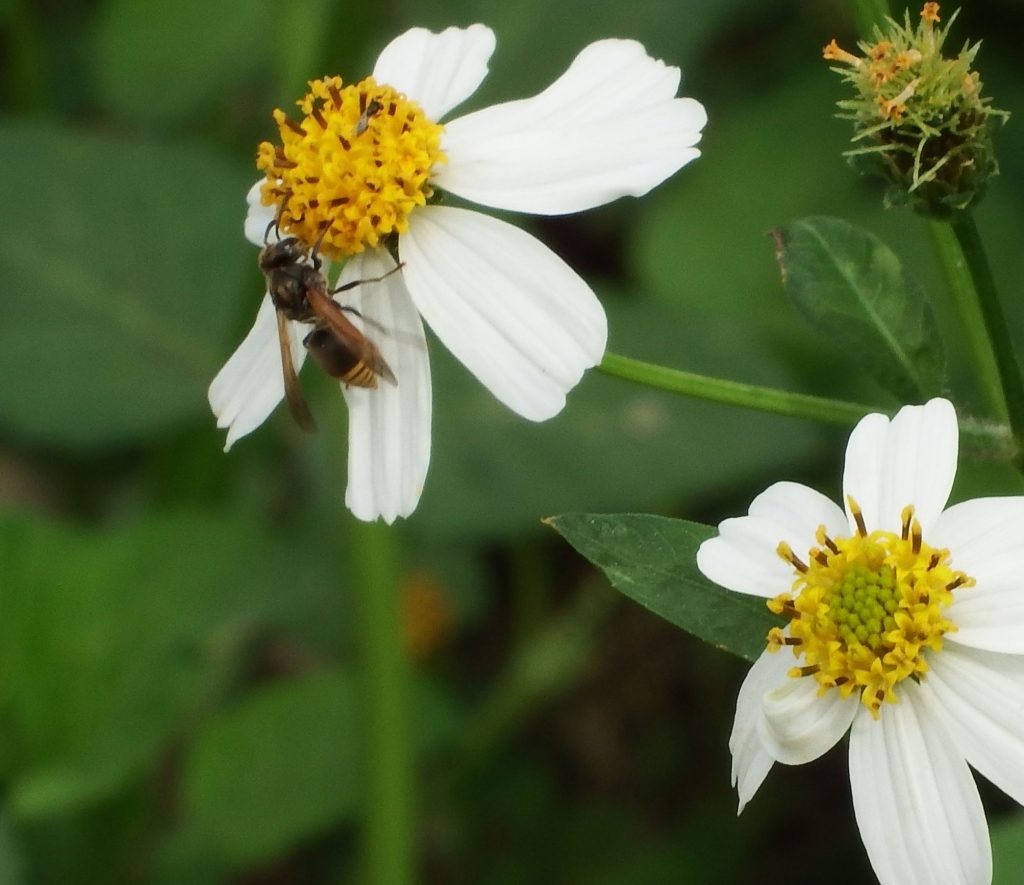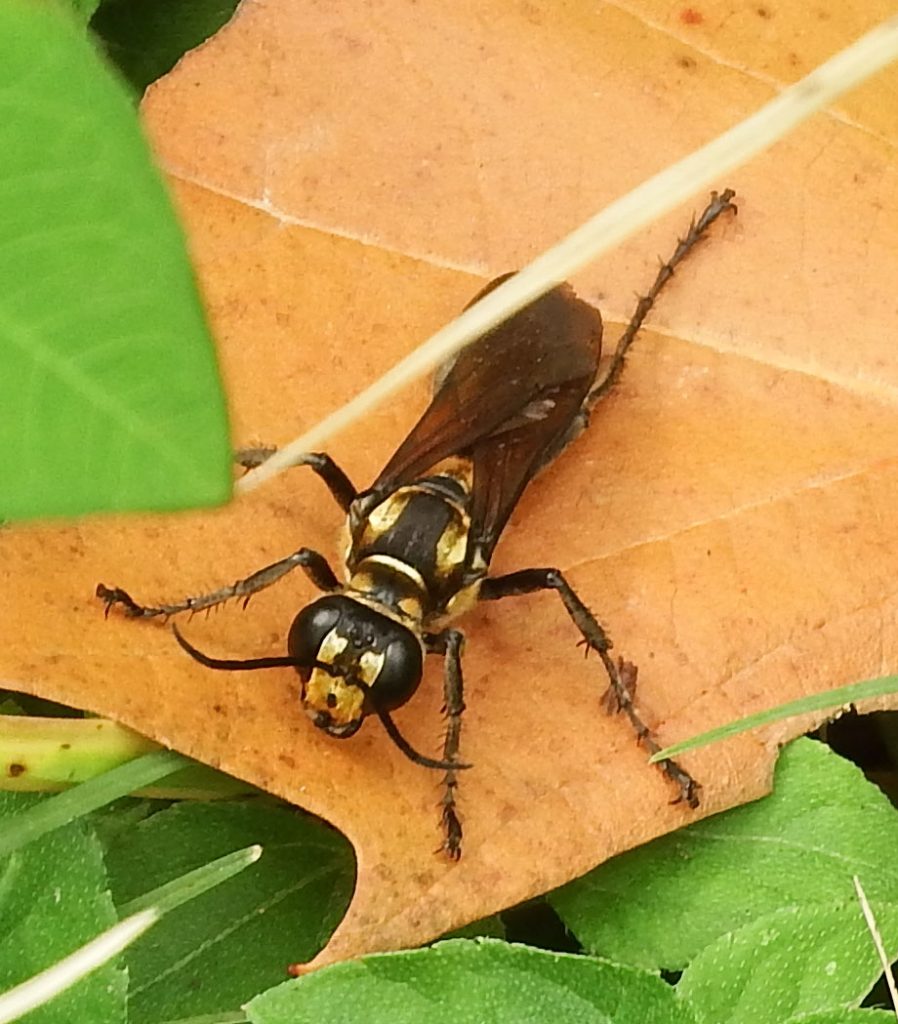Wasps. Hard to love, but let’s give it a try.

Bees and wasps have such different reputations. Bees are industrious and beneficial. Wasps are sadistic missiles with attitude. A bee gets in the house and I will lovingly carry it out in a water glass. But if a bunch of paper wasps set up shop behind a shutter, oh honey, where’s that can that sprays 50 feet.
The wasp’s reputation for viciousness is not completely unearned. Hornets and yellow jackets will mess you up and seem to enjoy doing it. But in checking facts for this post, I read up on paper wasps and their social lives are so complex and fascinating that I’m not sure I can any longer nuke every nest I find.
One of the wasps I found in the park is also a nest builder, but she is very non-aggressive. She’s a Mexican honey wasp. That’s her at the top of the post. She’s a type of wasp that makes large paper nests (like hornets) and produces honey, which is, I think, unique among wasps; even most bees don’t make honey. Mexican honey bees don’t range very far into the US; Texas is the only place you are likely to run into one. In Mexico, the honey and larva are considered delicacies.
While most wasps are not significant pollinators, Mexican honey wasps are great at it. That’s because they are hairy. Most wasps are not. The kind of hair on wasps and bees is structurally different than human hair. One of the features is that as the insects fly, their hairs acquire a static charge so that when the insect lands near pollen, it sticks to the hairs. No hairs, no pollen.
Before the arrival of Europeans and their ubiquitous European honey bees, the Mexican honey wasp was one of the main pollinators of mezzo-American crops including avocados for which they are still considered a primary pollinator.

Mexican honey wasp sipping nectar
But the Mexican honey wasp isn’t just looking for nectar when it visits flowers. It is also looking for a few types of insects it likes to eat. One of those is an introduced parasite that is harmful to the citrus crop. Mexican honey wasps are one of the main predators of that insect, making them very popular among citrus farmers.
This business of eating flesh is what distinguishes wasps from bees. They have a common ancestor but the evolutionary tree forks when bees went vegetarian. Basically, a bee is a wasp that doesn’t eat meat in any of its stages. All wasps eat meat at some point.

Golden reined wasp. He looks dipped in gold.
This golden reined wasp is enormous! About an inch long. When I saw him crawling through a field of frog fruit, he dwarfed the plants. I thought he must be hunting for pollinating prey so I videoed him expecting something horrific if I got lucky. Instead, I have him crawling from tiny flower to tiny flower delicately sipping nectar from each one. Adult golden reined wasps live on nectar. The larva, however, is a different story.
It is amazing how little I can find about the details of solitary wasp life. If a wasp is eusocial (a fancy way of saying lives in a colony sharing child-rearing responsibilities), there is a load of information down to the details of how everyone gets along. But solitary wasps must be hard to study. So here’s what I have pieced together from general information about wasps of her kind. She likely nests in the ground digging a long tunnel with side cavities for her eggs. Into each cavity, she will lay an egg and then stuff in a dead caterpillar or another once-living critter of an appropriate size. That critter might not actually be dead, it might just be paralyzed. When her egg hatches, it will eat on that paralyzed or (let’s hope) dead thing until the larva is big enough to transform into an adult golden reined wasp so he or she can go from flower to flower sipping nectar, hoping to get the taste of that one dead caterpillar out of her mouth.
I suspect she also manages to drag some pollen around with her/him. I see hairs!
A while ago, someone asked me what was the purpose of wasps. I had no idea. Of course, the correct answer to the question is that no living thing has a purpose beyond itself. But because we live on a planet where living things have rubbed up against each other (evolutionarily) for millennia, by now, we all fit together like puzzle pieces.
I now understand that it is this very carnivorous nature that is the purpose of wasps. They drag dead things beside their eggs, sometimes they lay their eggs right on a caterpillar or other host insect and the things just eat away on a living host. Wasps are your worst nightmare. The stuff of horror movies. But if we didn’t have them, we would be up to our hips in caterpillars and whatever else it is that those mother wasps drag dead or stunned into their nests. That doesn’t sound like much fun either.

